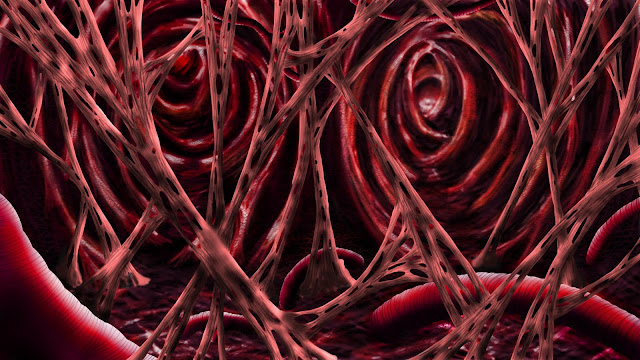Colour Styles
Saturday, 30 April 2011
Thursday, 28 April 2011
Wednesday, 27 April 2011
Final Storyline
1st Act
Starts of with an external view of an artery, then enters the artery to see blood cells rushing through it. Bacteria enter the scene and continue to flow with the blood cells. They are rushing through the artery like some roller coaster ride and eventually enter a lymph node.
2nd Act
The bacteria lurk about inside the lymph node looking for unsuspecting cells to damage. They are seen passing many B cells, which ignore them. Only the antigen matching B cells can catch them. The bacteria continue to swim pass them until they start to get captured by the matching B cells one by one. The B cells absorb the bacteria and expose the bacteria's antigen on their membrane surface and wait for further instruction.
3rd Act
T cells come along and begin activating the B cells by communicating physically and chemically to them. After the T cell has finished the B cell starts to divide into memory B cells and Plasma cells. The Plasma cells start releasing their antibodies, which seek out the bacteria in the lymph node and the rest of the body.
Starts of with an external view of an artery, then enters the artery to see blood cells rushing through it. Bacteria enter the scene and continue to flow with the blood cells. They are rushing through the artery like some roller coaster ride and eventually enter a lymph node.
2nd Act
The bacteria lurk about inside the lymph node looking for unsuspecting cells to damage. They are seen passing many B cells, which ignore them. Only the antigen matching B cells can catch them. The bacteria continue to swim pass them until they start to get captured by the matching B cells one by one. The B cells absorb the bacteria and expose the bacteria's antigen on their membrane surface and wait for further instruction.
3rd Act
T cells come along and begin activating the B cells by communicating physically and chemically to them. After the T cell has finished the B cell starts to divide into memory B cells and Plasma cells. The Plasma cells start releasing their antibodies, which seek out the bacteria in the lymph node and the rest of the body.
Environment Sketches
Inside a lymph node viewing the incoming artery entrance and vein exit. B and T cells populate the lymph node.
At the center is a lymph node with branching lymph fluid vessels coming from it. Main entrance is the artery on the far bottom left next to the vein.
Inside the main artery that leads to a lymph node.
Refined Antibody Design
The antibody's locking arms match those of the refined bacteria design. The antibody has small backward facing hooks in its clamps that help hold onto the struggling bacteria and prevent it from escaping.
Inspiration - Vaclav Pajkrt
These works by Vaclav Pajkrt are very inspirational and interesting in their design. The spiky and stringy shapes are what I imagine a lymph node's internal structure would look like.
Sunday, 24 April 2011
Refined Bacteria Design
I have given the bacteria a creepy look as well as making the antigens on its body spiked. Due to its many flagellum, the bacteria can move much faster than the B cells which have to catch this thing. This makes it more of a threat to the body it is invading.
Refined Plasma Cell Design
This diagram shows both its interior and exterior, the final outcome will be a translucent plasma cell.
Saturday, 23 April 2011
Refined T Cell Design
Showing its interior and exterior design. This cell will be translucent in the final designs. A T cell has what looks like tentacles, which looks as if it uses them to aid in communication between it and the B cell. By using them it can hold onto the B cell while connecting its receptor to the exposed antigen on the B cell's body. This is what tells the B cell to start dividing.
Refined B Cell Design
This diagram is just to show the interior and exterior of the cell. The final outcome will be a translucent B cell where the inside is slightly viewable through its skin
Friday, 22 April 2011
A look at Reptile & Aquatic Animal Skin Textures
Reptiles
Crocodile
Black Tiger Snake
King Brown Snake
Aquatic Creatures
Blue Ring Octopus
Gar Fish
Snow Flake Eel
Tesselata Eel
Various Discus Fish
The Gar, Tesselata eel and Discus have patterns that are the most interesting. I am influenced by these for designing the cells and blood vessel walls.
Subscribe to:
Posts (Atom)


















































